During my fifteen minutes of concentrated focus, I experienced cold temperatures, harsh winds, and tons of noisy birds. It was pretty cold; the weather was around 61 degrees, with a blanket of gray skies blocking the sun’s view from above me. Cold raindrops pushed past the leaves of the tree above me, dropping onto my journal (that’s not waterproof!) and knocking acorns down to the ground. The winds were pretty strong and came in from my north, smacking my skin with so much force, making me debate if I should go inside and come back out at a later date; I decide to stick it out. If I could focus on something else, maybe the weather wouldn’t seem so bad. Loud chatter filled the air, coming in from my southeast; I shrugged it off and started to observe the number of empty acorn shells on the ground. Maybe some critters were filling up their bellies for the winter.
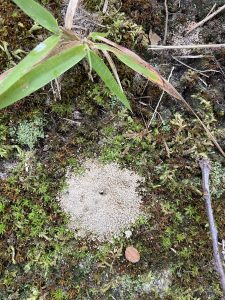
I then noticed a patch of a small circle of dirt above ground (probably formed by an insect) that was dry and light in color? I was confused because it had just rained last night, so how could there be a dry patch of dirt just sitting above ground. I was deeply puzzled by this, but my thoughts shifted as the chirping of those birds grew even louder. I had to investigate this; I got up to see what was going on with the birds. There were so many birds! It had to be around 50 birds flying back and forth from one tree to another in small groups. They did all this while chirping to the top of their lungs! I wondered what was going on, what exactly they were doing, and what could they possibly be saying to each other? I did manage to get some pictures and videos of the birds, but this was a sight to see.
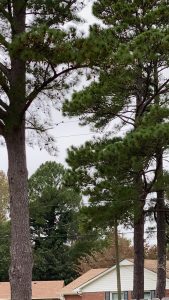 (The two trees that the birds were on)fullsizeoutput_5f22
(The two trees that the birds were on)fullsizeoutput_5f22
For updates on my followed organisms, I have some exciting news! When I was taking some pictures of the haircap moss, I stumbled upon something that looked like my mystery wooden ant hive. Last week when I was at my sit-spot, my object had vanished. I searched all over, but it just didn’t pop up, so crossing paths with it was great news. It was a little smaller in size but resembled the original hive. It looked as if the original hive had got into a fistfight. I do believe it is the original hive regardless of the new size.
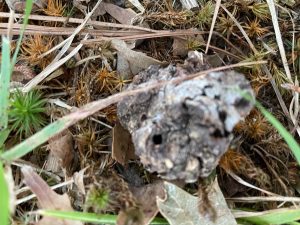
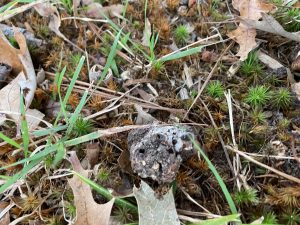
The tiny pine tree was doing alright; it has not grown much in size in awhile. It was also a little bent out of shape on one of its branches. I’m not sure why? Maybe wind/animal physically moving the branch or it was bending towards sunlight. Sort of a mystery until I can return in a week. The cherrybark oak tree is doing great! It has dropped a ton of more leaves, but it is still holding on to a lot of them. It is also showing more moss growth on its bark than before; I don’t know the cause of that, but I would like to look into it.
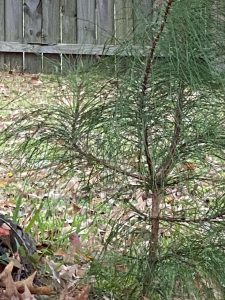 (Tiny pine)
(Tiny pine) 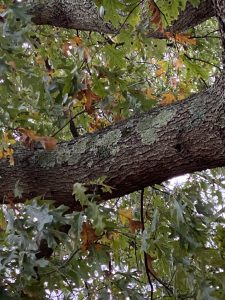 (Moss on the cherrybark)
(Moss on the cherrybark)
For an update on the identified species, the first one we can talk about is the Virginia creeper. The creeper that was growing on the side of the house was starting to turn red and orange. A sign that the creepers are changing along with the seasonal change. Though, the creeper that is a host to the cherrybark oak tree continued to be a very bright green showing no signs of a color change due to seasonal change yet.
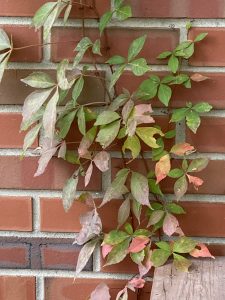 (Virginia Creeper)
(Virginia Creeper) 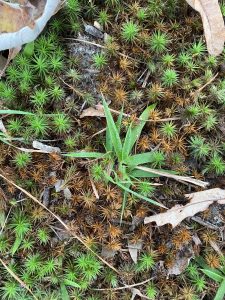 (Green and Brown Haircap moss)
(Green and Brown Haircap moss)
The haircap moss still was a very vibrant green and looked to be doing just fine. I also was able to snap some pictures of the brown hair cap moss. Which I now know isn’t dying, but is older.
The amanita mushroom was gone! I have no clue if it was eaten, walked over, or just died. It made me realize that nature changes every second and nothing is guaranteed to stick around.
For my one square meter space, I observed an area that fell between the cherrybark oak tree and a pine tree. I loved this because you were able to see how both the trees affect the area. The square was scattered in pine needles and dried dead leaves. It had a pine cone and an above-ground root on the right side of it and three medium-sized holes (definitely made by a critter) on it’s left. The space also had a couple of dirt patches. These patches could indicate some animals walking path or maybe whatever organism made those three holes caused the patches. I’m not sure, but I feel like there is some relationship between the two. On the above-ground root laid tiny white dots that were scattered randomly. I’m not sure if it was mold or moss beginning to form, but it is probably going to be a host to the root regardless.
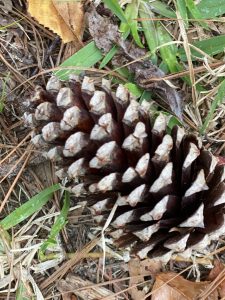
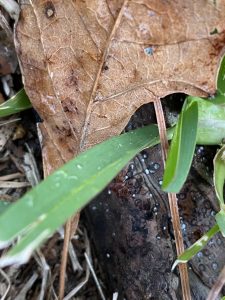
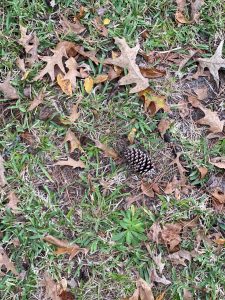
Overall, I had a good sit-spot experience despite the fact I had to deal with the not so great weather, and I can’t wait to investigate more on some of my mysteries.

Hi Zoe, the patch of dirt you captured seems very interesting. I have seen ants do that back home, so I wonder if it was ants who made it or some other insect. I thought it was interesting that the creeper host to the cherrybark oak tree hasn’t changed colors yet!
Hi Zoe! I love seeing pictures of your spot– it can be a nice change of scenery from here on campus, especially when looking at plants we don’t have here. I believe the pile of dirt you saw may have been caused by ants. Sometimes I will notice that they bring up a lot of dirt from below ground–making room for new tunnel systems maybe? I can’t wait to hear what else you learn about your mystery organisms!
Thank you for replying! You make a very good point about the ants making tunnels and bringing up the dirt below ground that probably was not saturated.
Hi Zoe, your sit spot looks so interesting! I am especially curious to know how the dry patch of sand was there despite the rain!
You’re brave to have chosen to withstand the cold, wind, and rain; I don’t think I could have! The behavior of those birds sounds so strange, I really wonder what they were up to.
Great post Zoe – I like how observant you are of this space and how many stories you are seeing playing out. I also like how you connect it back to concepts from class! Good work!